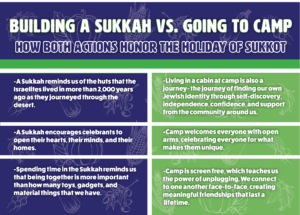As the holiday of Sukkot approaches, we wanted to take some time to reflect on the symbolism of the Sukkah, and its parallels with camp. No matter where we are in the world, we are individuals with unique personalities, interests, and backgrounds. When we are at camp, we are a community of individuals- we make up a strong community, and we are surrounded by people who celebrate us for our differences (we even have a sukkah year-round in our garden!). On Sukkot, we gather together in the Sukkah with a lulav and etrog in our hands, and we shake the two together in all directions.
The Midrash teaches that the 4 species that make up the lulav and the etrog represent a different type of Jew. The lulav has taste but no smell, symbolizing those who know the traditions of Judaism but do not practice them. The myrtle (hadass) has a good smell but no taste, symbolizing those who do good deeds but do not have knowledge of Judaism. The willow (aravah) has neither taste nor smell, symbolizing those who never study Torah and never carry out good deeds. The etrog has both a good taste and a good smell, symbolizing those who know the traditions of Judaism and apply them in their lives (Vayikra Rabbah 30:12)
At camp and during sukkot, we acknowledge and appreciate the diversity of our community, because we are empowered and strengthened when we come together as one. The mitzvah of Sukkot is fulfilled when all 4 species are held together. The magic of camp is created when we are strengthened by the people around us.
As we come together as individuals and as we bring the lulav and the etrog together in the Sukkah, we become one. Each part and each person complements the others. The community is strong because of its many parts, and together, we are one.
For the first time ever, you can have the best of both worlds; you can celebrate Sukkot at camp! Celebrate the journey, open your hearts, and unplug in the presence of friends and family at our Sukkot Family Retreat next weekend! Click here for more information.

